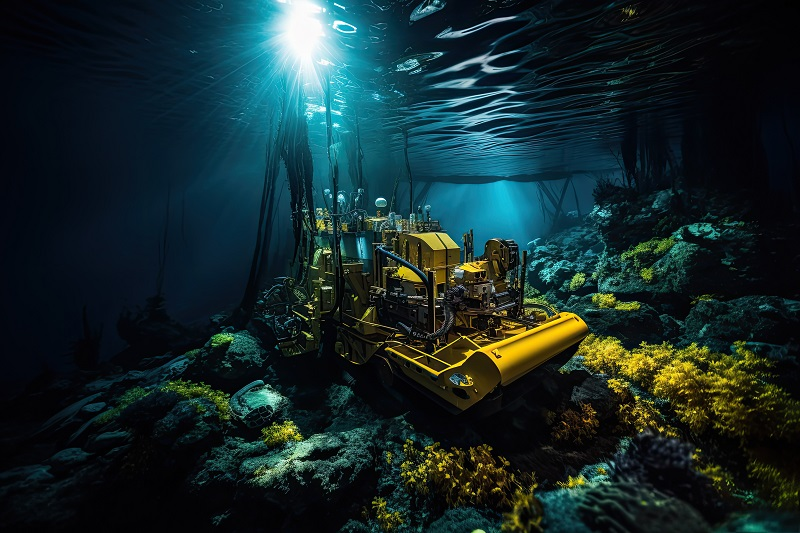
INTRODUCTION
Deep-sea mining drones are specialized robots designed to explore and extract valuable minerals from the ocean floor. These drones are part of a growing industry focused on tapping into the vast resources found in the deep ocean, such as rare-earth metals, copper, gold, and polymetallic nodules, which are rich in metals like nickel, copper, and cobalt.
As terrestrial resources become scarcer and demand for critical materials grows, deep-sea mining presents an attractive solution. Drones used for deep-sea mining can autonomously operate in extreme conditions where human presence is not feasible, such as depths of over 6,000 meters (19,685 feet), where high pressure, low temperatures, and complete darkness make operations challenging.
HOW DO DEEP SEA MINING DRONES WORKS
Deep-sea mining drones are often equipped with various tools and sensors to carry out a range of tasks, including:
- Seabed Exploration: Drones are equipped with cameras, sonar, and LIDAR to map and analyze the ocean floor for valuable mineral deposits.
- Mineral Extraction: Using remotely operated tools, drones can collect materials from the seabed. This can involve drilling, scraping, or vacuuming sediment and mineral-rich materials.
- Transporting Resources: Once the minerals are extracted, drones can transport the materials to the surface or to specially designed collection vehicles.
- Real-Time Data Transmission: Drones are equipped with communication systems that send real-time data back to operators, enabling precise control over mining operations.
TYPES OF DEEP SEA MINING DRONES
- Autonomous Underwater Vehicles (AUVs): These drones can operate autonomously, mapping the ocean floor, surveying for resources, and conducting geological analysis. AUVs are designed to operate without direct human intervention and can be deployed for long periods.
- Remotely Operated Vehicles (ROVs): These drones are controlled by operators from the surface. ROVs are equipped with more advanced tools for extraction and manipulation of materials, and they are often used in direct mining operations.
- Seafloor Crawlers: These drones move along the ocean floor like a land-based robot, using wheels or tracks to navigate and access hard-to-reach locations where minerals are located.
- Hydraulic Suction Drones: These specialized drones use suction devices to extract mineral-rich material from the seabed, sucking it into a container or pipeline for transport to the surface.
KEY FEATURES AND TECHNOLOGIES
- Pressure and Temperature Resistance: Drones are built to withstand extreme pressure (up to 600 times that of the surface) and freezing temperatures in the deep ocean.
- Advanced Sensors and Cameras: Equipped with sonar, cameras, and other imaging tools, drones can map and survey the seabed, helping to identify and quantify mineral resources.
- Energy Efficiency: Deep-sea mining drones often use high-efficiency power sources like batteries, hydraulic power, or energy harvesting technologies (such as wave power) to extend their operational range.
- Autonomous Navigation: Many drones are designed to navigate autonomously using GPS (where available), sonar, or inertial navigation systems to chart courses across the ocean floor without human input.
- Data Collection and Transmission: Drones gather vast amounts of data, from geological surveys to environmental monitoring, and transmit it back to researchers or mining companies in real-time.
ADVANTAGES
- Access to Unreachable Resources: Drones enable mining operations at depths and in areas that would be impossible for human divers or traditional equipment to reach.
- Reduced Risk to Human Life: Since drones are unmanned, they eliminate the risk to human workers in harsh underwater environments.
- Precision and Efficiency: Autonomous and remotely operated drones can work with high precision, reducing waste and improving the efficiency of resource extraction.
- Environmental Monitoring: Drones can also be equipped to monitor the environmental impact of mining operations, such as assessing the health of marine ecosystems, which helps mitigate negative impacts.
CHALLENGES AND LIMITATIONS
- Environmental Impact: Deep-sea mining can have significant ecological consequences, such as disrupting fragile ecosystems, destroying habitats, and polluting the ocean with sediment. Critics argue that the full impact of deep-sea mining on biodiversity is still not well understood.
- Cost and Investment: The technology involved in deep-sea mining, including drones and mining equipment, is costly to develop and deploy. The high cost of underwater operations could limit the scalability of the industry.
- Regulation and Oversight: There is limited international regulation governing deep-sea mining activities. Without comprehensive laws, there are concerns about the uncontrolled exploitation of ocean resources.
- Technological Challenges: Operating in extreme depths presents technological challenges, such as ensuring long-term reliability of drones, managing power systems in harsh environments, and maintaining communication over long distances.
APPLICATIONS OF SEA MINING DRONES
- Rare Earth Metals and Minerals: The primary goal of deep-sea mining is to extract valuable minerals used in electronics, renewable energy, and electric vehicle batteries, including cobalt, nickel, lithium, and copper.
- Oceanic Research: Drones can help scientists explore the deep ocean and study previously unknown marine life forms and ecosystems.
- Geological Mapping: These drones can conduct large-scale geological surveys of the ocean floor, uncovering new resources and helping to better understand the structure of the Earth.
- Environmental Protection: Some drones are equipped to monitor and track pollution levels, measure the impacts of mining operations on marine ecosystems, and ensure compliance with environmental standards.

